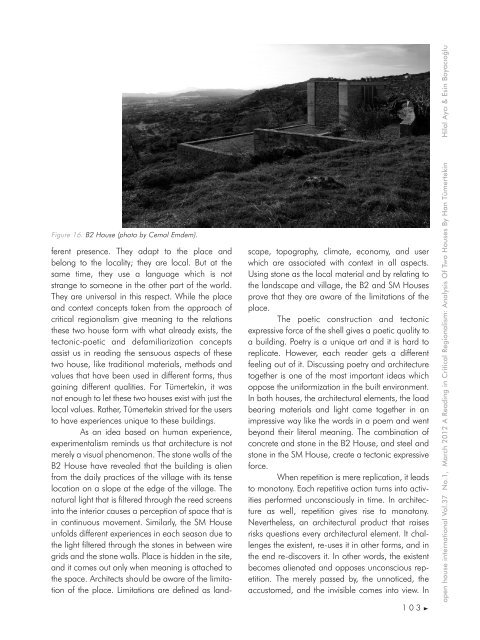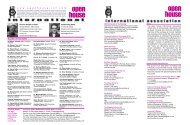Vol :37 Issue No.1 2012 - Open House International
Vol :37 Issue No.1 2012 - Open House International
Vol :37 Issue No.1 2012 - Open House International
Create successful ePaper yourself
Turn your PDF publications into a flip-book with our unique Google optimized e-Paper software.
Figure 16. B2 <strong>House</strong> (photo by Cemal Emdem).<br />
ferent presence. They adapt to the place and<br />
belong to the locality; they are local. But at the<br />
same time, they use a language which is not<br />
strange to someone in the other part of the world.<br />
They are universal in this respect. While the place<br />
and context concepts taken from the approach of<br />
critical regionalism give meaning to the relations<br />
these two house form with what already exists, the<br />
tectonic-poetic and defamiliarization concepts<br />
assist us in reading the sensuous aspects of these<br />
two house, like traditional materials, methods and<br />
values that have been used in different forms, thus<br />
gaining different qualities. For Tümertekin, it was<br />
not enough to let these two houses exist with just the<br />
local values. Rather, Tümertekin strived for the users<br />
to have experiences unique to these buildings.<br />
As an idea based on human experience,<br />
experimentalism reminds us that architecture is not<br />
merely a visual phenomenon. The stone walls of the<br />
B2 <strong>House</strong> have revealed that the building is alien<br />
from the daily practices of the village with its tense<br />
location on a slope at the edge of the village. The<br />
natural light that is filtered through the reed screens<br />
into the interior causes a perception of space that is<br />
in continuous movement. Similarly, the SM <strong>House</strong><br />
unfolds different experiences in each season due to<br />
the light filtered through the stones in between wire<br />
grids and the stone walls. Place is hidden in the site,<br />
and it comes out only when meaning is attached to<br />
the space. Architects should be aware of the limitation<br />
of the place. Limitations are defined as land-<br />
scape, topography, climate, economy, and user<br />
which are associated with context in all aspects.<br />
Using stone as the local material and by relating to<br />
the landscape and village, the B2 and SM <strong>House</strong>s<br />
prove that they are aware of the limitations of the<br />
place.<br />
The poetic construction and tectonic<br />
expressive force of the shell gives a poetic quality to<br />
a building. Poetry is a unique art and it is hard to<br />
replicate. However, each reader gets a different<br />
feeling out of it. Discussing poetry and architecture<br />
together is one of the most important ideas which<br />
oppose the uniformization in the built environment.<br />
In both houses, the architectural elements, the load<br />
bearing materials and light came together in an<br />
impressive way like the words in a poem and went<br />
beyond their literal meaning. The combination of<br />
concrete and stone in the B2 <strong>House</strong>, and steel and<br />
stone in the SM <strong>House</strong>, create a tectonic expressive<br />
force.<br />
When repetition is mere replication, it leads<br />
to monotony. Each repetitive action turns into activities<br />
performed unconsciously in time. In architecture<br />
as well, repetition gives rise to monotony.<br />
Nevertheless, an architectural product that raises<br />
risks questions every architectural element. It challenges<br />
the existent, re-uses it in other forms, and in<br />
the end re-discovers it. In other words, the existent<br />
becomes alienated and opposes unconscious repetition.<br />
The merely passed by, the unnoticed, the<br />
accustomed, and the invisible comes into view. In<br />
1 0 3<br />
open house international <strong>Vol</strong>.<strong>37</strong> <strong>No.1</strong>, March <strong>2012</strong> A Reading in Critical Regionalism: Analysis Of Two <strong>House</strong>s By Han Tümertekin Hilal Aycı & Esin Boyacıoğlu





